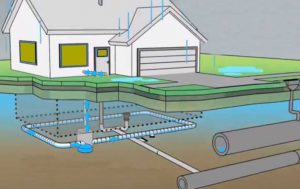Drainage & Sewage Installations
Are you worried about your choked drainage? Drop your worries when we come up with long-lived solutions for your drainage and sewage installations in Paphos.
Find out how!
We use PVC for all the fixations because PVC is lightweight, easy to handle, flexible, and offers excellent corrosion and chemical resistance. In addition, the smooth interior surface of PVC pipe provides exceptional flow characteristics.
Polyvinyl chloride (PVC) Sewer and Drain Pipe provide a conduit for the drainage of sewage, surface water, and industrial waste outside the building limits. This is where toughness, dimensional stability, resistance to aging, and strong tight joints are required.
When it comes to using pressure pumps, our company uses GRUNDFOS pumps. It is a Danish manufacturer of a wide range of centrifugal pumps and systems for water applications in industry, irrigation, heating, and wastewater treatment.

Diagram of a drainage and sewage system – source: TheConstructor.org
What is underground drainage?
Underground drainage is a system of pipes and other components that helps to move water away from buildings and other structures.
The most common type of underground drainage is a sewer system. It collects wastewater from homes and businesses and carries it to a treatment plant. However, underground drainage can also be used to collect stormwater, which is then discharged into a natural water body such as a lake or river. In addition to pipes, underground drainage systems often include catch basins, manholes, and drainage basins.
These features help to collect and channel water away from buildings, preventing flooding and protecting against water damage.
Different pipe types
Drainage and sewer pipes are made from a range of different materials including vitrified clay, uPVC, concrete, iron and asbestos. This page deals only with solid pipes; perforated pipes for land drainage schemes are dealt with on the land drainage page. Most domestic drainage used in Britain and Ireland is either clayware or plastic, with plastic uPVC drainage systems. They’ve become more popular in modern, especially in post-1980s properties. Consequently, only clayware and plastic drainage will be considered here.
Other materials used for drainage pipes include ductile and cast iron (CI), glass fiber-reinforced plastics (GRP), high-density polyethylene (HDPE), concrete, asbestos, and pitch fiber.
What does invert level mean?
The invert level is the lowest point of a conduit, sewer, or other drainage structure. It is typically represented as “I.L.” on construction drawings. The invert level is used to determine the slope of the pipe. It is also used to calculate the volume of water that can flow through the pipe. The invert level can be measured with a laser level or a transit.
Contact our experts for a FREE QUOTE!
You can also call us at +357 26 941 555.
We also offer services to the cities below:
COST CALCULATOR
Use our form to estimate the initial cost of renovation or installation.
REQUEST A QUOTE